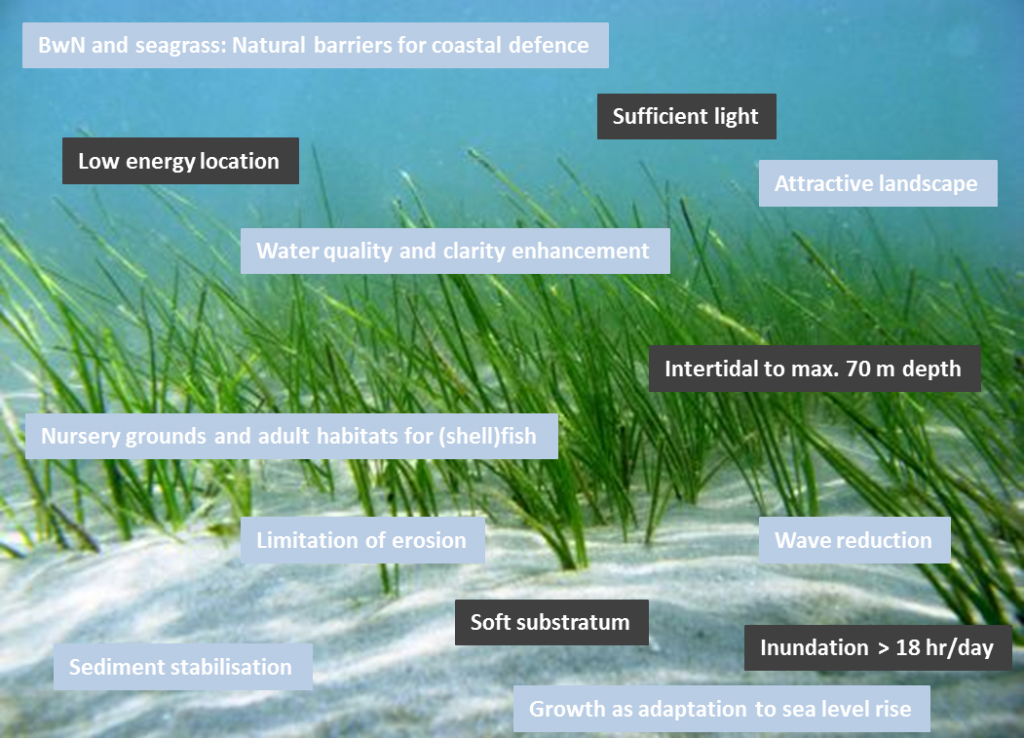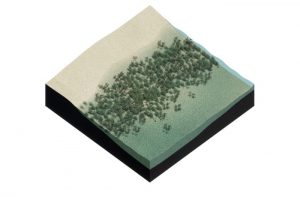Get Started
This concept focuses on the creation of suitable conditions for seagrass meadows that change the near-bed flow and dissipate wave energy in shallow water, thereby influencing sediment transport, erosion and deposition. Including a seagrass meadow in a coastal defence design requires integration of ecological and engineering knowledge. A first assessment can be done with limited site-specific knowledge, for instance making use of local and historical data. Subsequently, for each new case a detailed feasibility assessment has to be made, integrating generic and site-specific ecological and engineering knowledge with socio-economic aspects. The latter are important because human activities such as urban and industrial runoff, urban and port infrastructure development and dredging are currently among the major threats to seagrass ecosystems worldwide (Grech et al., 2012).
This concept describes the habitat requirements for intertidal seagrass meadows in soft sediment habitats and can be used to check whether a certain location is suitable or can be made suitable for the establishment of intertidal seagrass meadows.
Required skills
With this manual, anyone having a basic level of knowledge and/or working experience on coastal systems can make a first-order assessment. To fully assess the suitability for seagrass meadows one should have additional ecological expertise on seagrasses.
BwN interest
The added value of this tool within BwN-type projects is that it enables the creation of coastal protection systems including meadow-forming ecosystem engineers. Ecosystem engineers are certain key species that influence their own environment and form structurally complex habitats. They aim to combine the intended function, e.g. coastal protection and/or associated economic and social returns, with habitat restoration/conservation by enhancing biodiversity, for instance.

Advantages
- Decreases shore erosion by dissipating wave-energy
- Stabilises the seafloor
- Traps sediment by which it improves the light penetration and reduces turbidity
- Provides shelter for other species. Seagrass beds provide nursery grounds and adult habitats for fish and shellfish
- Water quality improvement through filtering nutrients and contaminants
- Seagrass meadows play a vital role in supporting coastal and marine communities and in maintaining diverse flora and fauna.
- Can keep up with a (certain) rate of relative sea level rise by sediment trapping.
Disadvantages
- Sensitive to sulphite toxicity
- Will not develop on a steep seabed
- Not suitable for high energy locations
- Not good at handling urban/industrial runoff, urban/port infrastructure development, agricultural runoff, dredging, trawling, aquaculture, boat damage, shipping accidents and changes in sea surface termperature.
- Present (eco)system can be degraded. However, the current ecosystem functioning could also be enhanced by seagrass.
Seagrass habitat requirements
The description of the seagrass habitat requirements is based on the 4-spheres approach: biosphere, hydrosphere, lithosphere and atmosphere, which interact with each other and cannot be evaluated on their own. The biosphere includes all living organisms, the hydrosphere relates to water in or near the earth, the lithosphere is the solid materials, soils and rocks, while the atmosphere relates to the weather and climate. For each of these spheres the relevant parameters are described. The limit values of these parameters for a seagrass ecosystem to establish are provided if they are known and generally valid and applicable. These values are derived from literature.

Note that habitat requirements for seagrass development may differ according to the state of seagrass development (e.g. bare sediment on which seagrasses may develop – seagrass pioneer vegetations – seagrass climax vegetations). Moreover, habitat requirements for seagrass meadows supporting a certain ecosystem service may differ from habitat requirements for seagrass development alone.
For more detailed information on the spheres, given in the image above, click the links below.

